USC Football Defensive Preview
Strong defensive line, opportunistic secondary. What could go wrong?
The top teams in the conference this year (except perhaps Utah) all have one thing in common this year: offensive-minded gameplans where it feels like the defense’s job is to supplement the offense, instead of the other way around. The top 4 scoring teams in the conference this year average about 40 points per game (Oregon: 42.4, USC: 41.0, UW: 40.4, UCLA: 39.6), while the top 4 defenses now give up somewhere between 20.8 to 24.0 points per game. This contrasts to prior to the pandemic season(s), when the Pac-12 had multiple elite defenses (2019 Utah gave up 13.2 points per game, 2019 Oregon gave up 15.7 points per game, 2018 UW gave up 15.5 points per game, etc.). Just aggregating the top 3 teams in the conference, a top 3 team in 2022 would average 41.3 points on offense and allow 21.7 points on defense, whereas in 2019 those numbers are 35.2 points on offense and 16.4 points allowed on defense. This is just my long-winded way to say that there’s a lot of offense in the Pac-12 this year, and not so much defense.
Like Cal saw with Washington and Oregon, USC will again try to score a lot of points on offense, and hope their defense is able to get just enough stops or turnovers that they can then immediately turn into points again on offense. Because these top offenses score points so efficiently, the goal of the defense is to just slow the opponent (e.g. UW gives up 27.6 points per game, Oregon gives up 28.4 points per game).
USC has an elite offense, but I am lukewarm on their defense (like I was with UW and Oregon, not that it mattered). They have a strong defensive line, and they hope that they can pressure opposing quarterbacks into mistakes resulting in turnovers— either strip sacks or interceptions. USC is #1 in the FBS in turnover margin per game at +2.0 (16 turnovers netted through 8 games, 17 gained with only one lost).
USC’s defense plays aggressively; they remind me of a much better version of Dykes’ teams. Play aggressive defense and go for takeaways: either it works and you get an extra possession, or if you miss and give up a touchdown, it’s fine, the offense will just score right back anyway. The games tend to stay close, until they aren’t.
Defensive line
The strength of this defense is the defensive line, anchored by soon-to-be NFL defensive lineman Tuli Tuipulotu. In years prior, he played defensive tackle, but he’s been moved to defensive end this year (although he will still occasionally line up elsewhere on the defensive line). That is, he’s moved from lining up over the offensive tackle most often to lining up outside him. As a result, it seems Tuipulotu feels most comfortable attacking gaps rather then beating tackles to the outside. Tuipulotu has good power and balance. Here he gets a sack as an interior defensive lineman after driving his blocker back into the QB:
And here he uses his power to drive the tackle backwards until he can get a hold of the QB:
Tuli Tuipulotu is good with his hand fighting and counters, which he uses to disengage blockers:
Here he wins going speed-to-power:
On the other end of the line is DE Nick Figueroa (technically listed as the backup on the depth chart, but plays plenty of snaps with Tuipulotu as USC will vary their defensive fronts, 4-2-5, 3-3-5, etc). Figueroa also doesn’t strike me as a natural defensive end, as he also prefers to work his way back inside:
That said, Figueroa is another versatile defensive lineman who can handle playing the variety of alignments USC asks of him. He’s 2nd on the team in sacks (4.5), behind only Tuipulotu (7).
The space-eating run-stuffer in the middle is NT Stanley Ta’ufo’ou, who has shown himself to be very solid against the run:
Someone who did strike me as a natural defensive end (although his official position on the depth chart is now closer to an outside/rush linebacker) is the former 5-star edge rusher Korey Foreman. He’s become a lot more lean this year (dropping 20 lbs. per the official roster), but he’s yet another versatile force on the defensive line, with a variety of pass rush moves, speed, and power to beat any kind of blocker:
Here Foreman’s speed catches the tackle flat-footed:
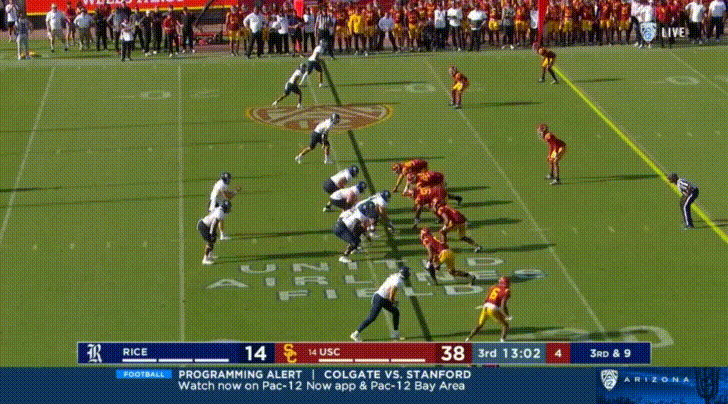
(Note that the above play has Tuipulotu, Figueroa, and Foreman as 3 of the 4 pass rushers on the play).
I have not seen enough of Foreman in pass defense to have formed an opinion here, but I would have to guess he’d be a bit raw in comparison with his pass rushing ability. It’s hard to say which USC defensive lineman will be harassing the Cal QB the most (probably most of them), but I’d have to guess it’d be the guys lining up over and outside the tackles, like Tuipulotu.
Linebackers
Korey Foreman’s actual position is officially listed as “RUSH”, which I feel is more functionally similar to an outside linebacker (but I usually like to put all my pass rushers in the defensive line section), so I’ll start with that position first here.
The starting “RUSH” is Solomon Byrd, who is solid both rushing the passer and defending the pass. Byrd is actually a transfer from Wyoming, which is not one of the squares I had on my USC transfer bingo card (most of the squares are Pac-12 teams, as Lincoln Riley loves to poach from conference mates, that ultra-dry brisket-cooking son of a gun).
Here Bryd uses speed to beat the slow-moving tackle:

Here, Bryd looks to be responsible for the running back, and runs a green dog blitz when it appears Filkins is sitting in pass protection for a moment:
The linebacker you will see (and hear about) the most is the ASU transfer Eric Gentry. Eric Gentry is listed as 6’6” 200 lbs, but has a reported 7’1” wingspan. While ASU used him (relatively inefficiently) as a pass rusher, USC decided to put him right in the center of the defense at middle linebacker, where his long gangly arms frequently get in the way of the throw. His long arms let him do things that other players can’t. Here, regular-sized human Cam Rising throws a nice stiff-arm on Gentry, but Gentry uses his 12 foot long arms to chop Rising down anyway:
Quarterbacks often need to fit a throw over a linebacker and in front of a defensive back, and Gentry’s long arms make that much more difficult than most QBs are used to. Here, Gentry’s reach forces the QB to throw a bit too high for his much smaller (5’8”) running back:
Similarly, Stanford QB Tanner McKee can drop in a throw as well as any, but Gentry’s presence forces this throw for his tight end to also be too high, this time resulting in an interception by the defense:

It’s not something that will show up on a stat sheet, but I am sure it annoys quarterbacks.
His wiry frame is naturally an advantage in pass coverage:

At WLB is the Alabama transfer, Shane Lee. Shane Lee is a compact, powerful linebacker, adept at rushing the passer and defending the run. Here he fights through a block for a sack on the blitz:
And here he rushes with enough speed that the slippery Jayden de Laura couldn’t escape:
Here he finds himself in the right place and right time for a pick-6:
Although he’s good at run defense and pass rushing, his weakness seems to be in pass coverage, and a couple of teams have found ways to exploit that.
Secondary
This is an extremely aggressive secondary, with boom-or-bust play. Their corners play extremely physically (to the point where I don’t know how they don’t draw more pass interference flags), and the defensive backs will take gambles trying to jump routes, strip the ball, etc., over making the tackle whenever possible. Last year’s #2 corner for Colorado is now the star cornerback for USC, Mekhi Blackmon.
Blackmon does a good job in man coverage, sticking to his receiver, and doing his best to disrupt a receiver (either rerouting him, or a ton of hand-fighting, etc):
CB Mekhi Blackmon does a great job shadowing his receiver:
And here’s the type of play I’m talking about with disrupting a receiver and surprisingly not drawing a flag:

He’s also shown some nice ball skills:
The other player to keep an eye on is the safety Calen Bullock. Just a true sophomore (after starting as a true freshman), USC is expecting big things from the natural ballhawk:
Calen Bullock also has nice pass coverage skills:
After those two, there’s a bit of dropoff to the next best pass defender.
The other safety is Max Williams. Per PFF, Williams is targeted more than twice as often as Bullock is. Here he is making a nice tackle for a forced fumble:
Another oft-targeted defensive back is the starting nickel, Jaylin Smith. Smith is a pretty good tackler. Like other USC DBs, he’ll push the boundaries on what he can get away with PI-wise:
Jaylin Smith is a true sophomore, and the starting corner opposite of Mekhi Blackmon is a redshirt freshman, Ceyair Wright. Wright has been experiencing some growing pains early. These 5 defensive backs have received the vast bulk of the snaps, meaning that USC isn’t particularly deep in the secondary. I know the interception numbers tell a different story, but I’d give some credit to a front-7 creating havoc; tips and deflections play a huge role in USC’s gaudy turnover figures.
Conclusion
The Cal offensive line will again struggle against a defensive line featuring at least one NFL-bound defensive lineman. If Cal’s quarterback can survive the pressure, there will be opportunities downfield. For Cal to have a chance, they’ll need to minimize turnovers, and also never settle for field goals. USC’s offense will pretty much always answer with touchdowns, so Cal’s offense would need to capitalize on the few occasions they do get stops/turnovers/etc. Also worth pointing out that USC’s defense generally struggles in the first half, and then plays much better in the second half after making halftime adjustments. I expect Cal will look somewhat competitive in the first half before USC pulls away in the second (and I would have predicted this at any point in the season, actually). Basically, another repeat of the Oregon game, unfortunately.
Go Bears.
You can find my full clips here.




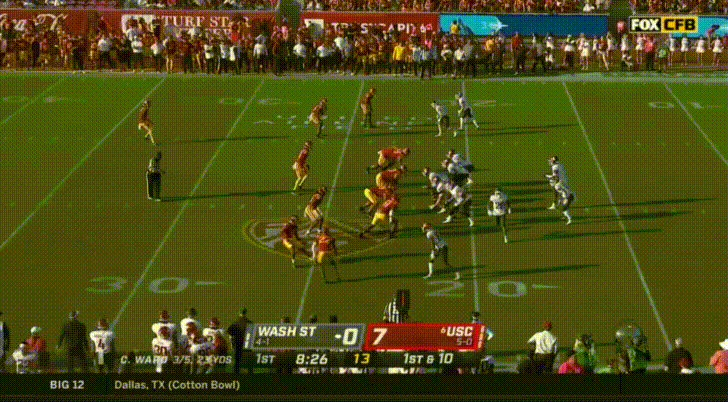

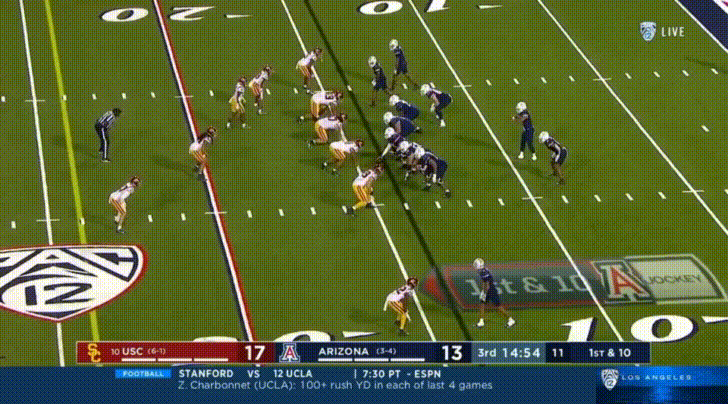


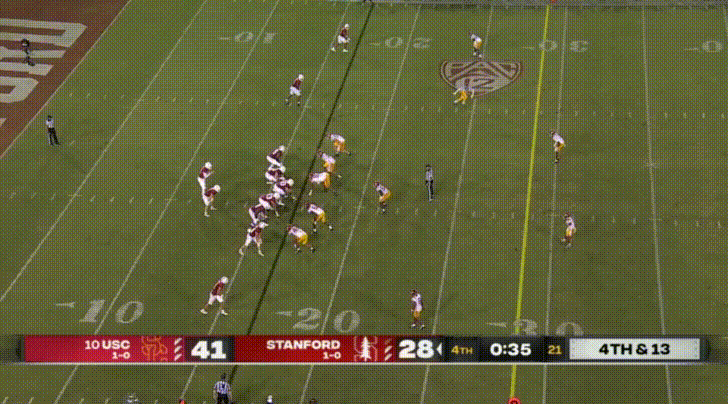






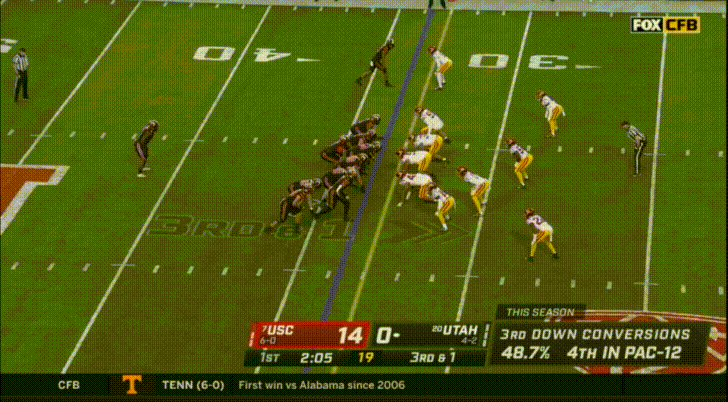



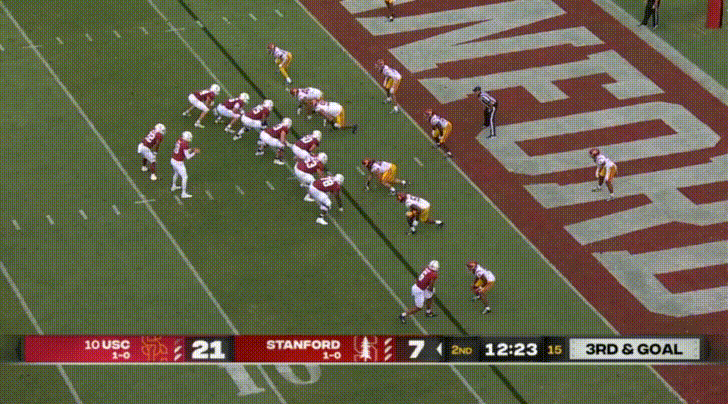

Any chance we can convince USC to count alligators before they rush?
Thanks for the write-up. Looking to see the Bears staying close, at least for awhile depending on our offensive prowess ( if that can be said) at least for a bit of time.